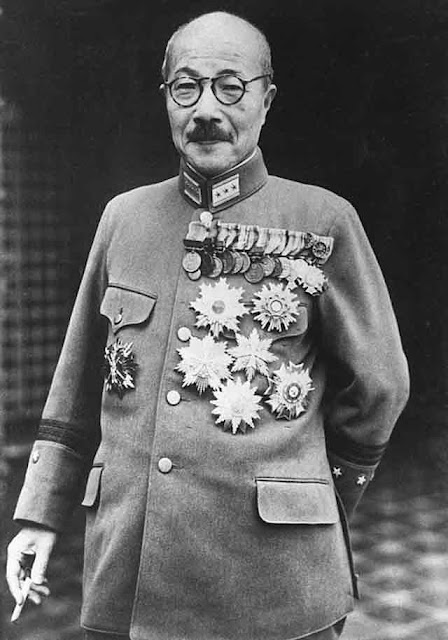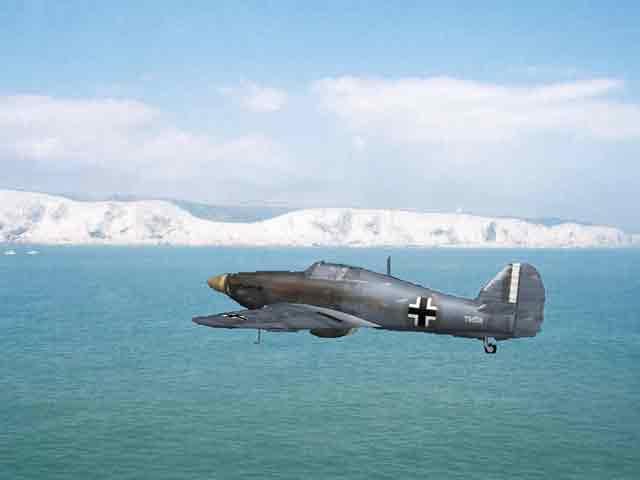Saturday 18 October 1941
 |
| General Hideki Tojo. |
Japanese Government:
18 October 1941 is the day when the final card is dealt out in the grand poker game known as World War II. On the Allied side, we have Franklin D. Roosevelt, President of the United States since 1933; Winston Churchill, Prime Minister of Great Britain since 1940; and Joseph Stalin, leader of the Soviet Union since the 1920s. On the Axis side, there is Adolf Hitler, Fuehrer of the Greater Reich since 1933; Benito Mussolini, leader of fascist Italy since the 1920s; Ion Antonescu, Prime Minister and Conducător of Romania since 1940; and now, at last, the final major leader of the conflict. His name is Hideki Tojo, and on 18 October 1941, General Tojo becomes the wartime leader (under the remote and sympathetic supervision of Emperor Hirohito) of Imperial Japan.
 |
| A man and his medals. |
Tojo, known as Kamisori (the Razor), succeeds Prince Konoye (Konoe), who has resigned due to his failure to broker a peace deal with the United States. Everyone knows what the promotion of Tojo, the leader of the war faction in the cabinet, to the top slot means. Prince Takamatsu immediately writes in his diary:
We have finally committed to war and now must do all we can to launch it powerfully. But we have clumsily telegraphed out intentions. We needn't have signaled what we're going to do; having [the entire Konoye cabinet] resign was too much. As matters stand now we can merely keep silent and without the least effort war will begin.
This is hardly an enthusiastic endorsement for total war.
 |
| A typical American depiction of Hideki Tojo. |
In order to better control what really matters during his tenure as Prime Minister, Tojo also continues to serve as War Minister. He becomes a widely caricatured figure in the United States, usually depicted with inhuman features and becoming the repository in the Western press of every negative stereotype and characteristic that can be flung at him. The media launches on a campaign to demonize Tojo, a time-honored tradition during wartime, and absolutely succeeds. Leading wartime Japan becomes one of the most thankless jobs of the conflict, not even earning the eternal scorn of Hitler or enduring the ridicule of Mussolini. Instead, Tojo just becomes yet another barbarian in the public mind, a savage who rides a bomb hurtling to earth and then falls off before it explodes - only to perish along with his nation. Whether this accurately summarizes the man is not really of consequence, as this is the image that lasts.
 |
| A Panzer IV on a low loader near a bridge at Merlyn, France, 18 October 1941. The Panzer IV was the main German battle tank at this time. Note the short barrel main gun, likely a 75 mm (2.95 in) Kampfwagenkanone 37 L/24 (7.5 cm KwK 37 L/24) tank gun. This howitzer-like low-velocity gun that only fired high-explosive shells already was proving obsolete against the Soviet T-34 and KV tanks. (Federal Archive Picture 146-1994-011-23). |
Konoye eventually convinces himself that the fault lies not in his stars, but in his... Emperor:
Of course, His Majesty is a pacifist, and there is no doubt he wished to avoid war. When I told him that to initiate war is a mistake, he agreed. But the next day, he would tell me: "You were worried about it yesterday, but you do not have to worry so much." Thus, gradually, he began to lean toward war. And the next time I met him, he leaned even more toward war. In short, I felt the Emperor was telling me: "My prime minister does not understand military matters, I know much more." In short, the Emperor had absorbed the views of the army and navy high commands.
The truth is somewhat more complex. Emperor Hirohito does not so much become a supporter of war as an opposer of other alternatives. Hirohito alone seems to understand the true choice being offered, and why this dilemma must resolve in the direction of a self-destructive conflict. He willingly embraces a Kabuki Dance of Death that can have only one outcome.
 |
| Feldwebel (sergeant) Heinrich Schultz (Schulz) (DK), a Gefreiter Flammenwerferschütze (flame thrower of the rank of corporal) in the 3./Pionier-Bataillon 161 when he won the Knight's Cross. This photo was taken on 18 October 1941. Note that he won the Knight’s Cross as an individual soldier and the German Cross as a group leader. He is often confused with another Heinrich Schulz. Fate unknown. |
Being a supporter of war only because no alternatives seem workable may seem a distinction without a difference in terms of whether or not one actually desires war. However, the fact is that President Roosevelt and the United States have completely boxed Imperial Japan into a corner. There is only one honorable way to exit this predicament, and it is not peaceful. Tojo's sole virtual is that he offers a solution that does not involve humiliation - at least, not away. Everyone may secretly understand (as they apparently do, according to later accounts) that Japan cannot possibly beat the United States and Great Britain in the long run. However, there is an almost conscious decision made that it is better in this situation to die with honor than surrender in despair. That this imperils the entire nation, let alone the Empire, is of small consequence next to the fear of losing face.
 |
| If this aircraft looks wrong to you somehow, you have a keen eye. This is an RAF No. 208 Squadron Hurricane Mk IIB that was captured by the Germans near Sollum in North Africa on 18 October 1941. The Allies in turn later recaptured it. It was quite common to put captured aircraft in your own markings, but you had to be careful where you flew it - the antiaircraft gunners down below and your fellow fighter pilots often don't notice the markings. |
Tojo is a devoted subject of the Emperor and sometimes acts - sometimes to the nation's detriment, as will soon become apparent - contrary to the nation's best military interests in order to demonstrate that. He understands that the Emperor would prefer a peaceful outcome, and thus craftily makes his first radio speech as prime minister on the subject of "world peace." However, Tojo is an outright hawk who seeks the final conquest of China, the establishment of a Greater East Asia Co-Prosperity Sphere in the western Pacific, and - most disastrously of all - a grand settling of scores with the United States. It is possible now - if you really try - to see Tojo as a tragic figure, a humbled, pathetic, and hopeless man alone on an enemy witness stand awaiting certain death. On 18 October 1941, however, Hideki Tojo is a figure of menace and ready to deal out the Ace of Spades across half the globe.
 |
| The Daily Express of 18 October 1941 shows what is on everybody's mind around the world: Stalin's doomed attempt to hold off the Wehrmacht. The common wisdom is that Stalin soon will breathe his last breath as the panzers crash through the crumbling Soviet defenses and roust the Soviet premier from his last stand. It is all so hopeless, and the heroic reporter states that Moscow is under martial law as the citizens prepare for their last stand. |
October 1941
October 1, 1941: Germans and Finns Advance in USSR
October 2, 1941: Operation Typhoon Broadens
October 3, 1941: Air Battles Near Moscow
October 4, 1941: Stalin Contemplates Defeat
October 5, 1941: Hoth Goes South
October 6, 1941: First Snowfall After Dark
October 7, 1941: Stalin Gets Religion
October 8, 1941: FDR Promises Stalin Aid
October 9, 1941: FDR Orders Atomic Bomb Research
October 10, 1941: Reichenau's Severity Order
October 11, 1941: Tank Panic in Moscow
October 12, 1941: Spanish Blue Division at the Front
October 13, 1941: Attack on Moscow
October 14, 1941: Germans Take Kalinin
October 15, 1941: Soviets Evacuate Odessa
October 16, 1941: Romanians Occupy Odessa
October 17, 1941: U-568 Torpedoes USS Kearny
October 18, 1941: Tojo Takes Tokyo
October 19, 1941: Germans Take Mozhaysk
October 20, 1941: Germans Attack Toward Tikhvin
October 21, 1941: Rasputitsa Hits Russia
October 22, 1941: Germans Into Moscow's Second Defensive Line
October 23, 1941: The Odessa Massacre
October 24, 1941: Guderian's Desperate Drive North
October 25, 1941: FDR Warns Hitler About Massacres
October 26, 1941: Guderian Drives Toward Tula
October 27, 1941: Manstein Busts Loose
October 28, 1941: Soviet Executions
October 29, 1941: Guderian Reaches Tula
October 30, 1941: Guderian Stopped at Tula
October 31, 1941: USS Reuben James Sunk
2020







No comments:
Post a Comment